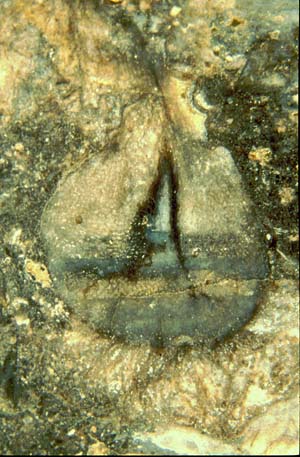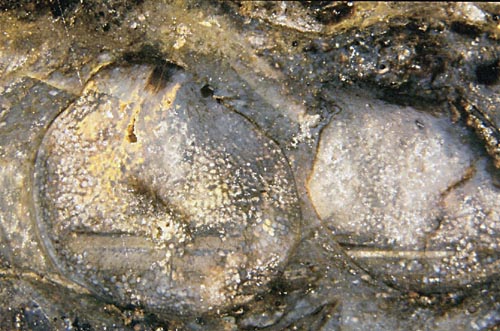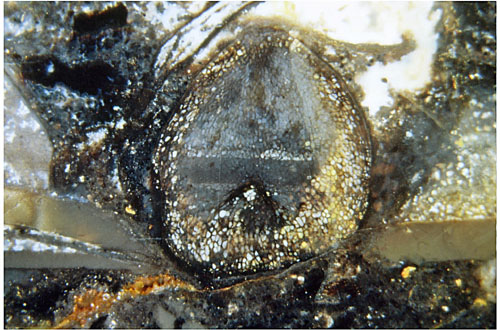Horneophyton
tubers – a preferred site for level
bands in chalcedony
Level
bands in chalcedony, also known as onyx agate, Uruguay bands, or
geopetal fills, are frequently found in the Rhynie chert (Lower
Devonian), usually in former cavities, as swamp gas bubbles, hollow
straws, sporangia, and arthropod moults. They are generated when
hydrated silica clusters suspended in water make an emulsion which
settles, thus forming a perfectly level boundary with clear solution
above, subsequently fixed by gel formation and further silicification.
Stacks of parallel bands
result from repetition, modification, and even occasional reversion of
this process.

The level bands are seen unexpectedly often in the tubers
of the small plant Horneophyton
(Fig.1). (The tubers can persist in the
ground while the upper parts wilt and dry, much like the recent onions.
Therefore they are often found separately, as in these pictures.) The
bands are there although the tubers have never been hollow. They go
right through the distinctly seen tissue as if it were not there, which
is very peculiar (Figs. 2-4).
Fig.1: Horneophyton
tubers with level bands in Rhynie chert.
Note also the very thin level line in the tuber
below right. Width of the picture 20mm.
Figs.2,3: Horneophyton
tubers with level band
stacks: Slight tilting during silicification is evident.



Fig.4 (left): Horneophyton
tuber in Rhynie chert with
level bands formed independently within the tissue and outside. The
deformation on the left indicates small-scale disturbances during
silicification of the inundated habitat. Width of the tuber 4mm. (The
tubers are usually pictured in drawings much too big by factors up to 5.)
Although many a
detail of the phenomenon will probably remain obscure, a few facts seem
to be certain: Dissolved silica in the form of siliceous acid tends to
polymerize into clusters, a process which is sensitive to the pH and
the presence of other substances in the water. Apparently the decaying
Horneophyton
"onions", with the cell content mostly turning into a
watery solution, had a special "smell" favouring the formation of
siliceous clusters of the right size to form a suspension which
settles,
thereby forming a horizontal boundary between suspension and clear
solution.Also it is thinkable that the decay
products of the cell plasma
formed suspensions with boundaries, which influenced the deposition of
SiO2
.This must have occurred while the tissue was
still coherent
but the cell walls were slightly perforated so that the clusters could
move through by diffusion
and form horizontal bands as if the cell
walls were not there.
It is also possible that the horizontal bands in Rhynie
chert hint
at hitherto neglected peculiarities of the silicification process.
H.-J.
Weiss
2008 completed
2011
 |
 |
27 |







